Mere Natural Law: Originalism and the Anchoring Truths of the Constitution. By Hadley Arkes. Reviewed by Fr. Stephen Rocker. (skip to review)
God Loves The Autistic Mind. By Fr. Matthew Schneider, LC. Reviewed by Fr. Mark Nolette. (skip to review)
Fed by the Lord: At-Home Scriptural Formation to Prepare Children for First Communion. By Leonard J. DeLorenzo. Reviewed by Robert Miller, Ph.D. (skip to review)
Let Beauty Speak: The Art of Being Human in a Culture of Noise. By Jimmy Mitchell. Reviewed by Maria Cintorino. (skip to review)
Forgiven: A Guide to Confession and the Examen Prayer. By Sr. Orianne Pietra René Dyck, FSP, and Sr. Allison Regina Gliot, FSP. Reviewed by Lawrence Montz. (skip to review)
Mere Natural Law – Hadley Arkes
Arkes, Hadley. Mere Natural Law: Originalism and the Anchoring Truths of the Constitution. Washington, D.C.: Regnery Gateway, 2023. 307 pages.
Reviewed by Fr. Stephen Rocker.
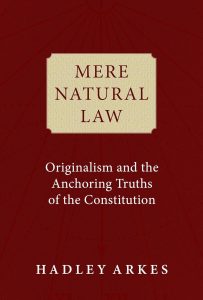 Hadley Arkes writes to show the axioms of reason and the moral principles that must be supposed in legal reasoning. Arkes criticizes not only moral relativists, but precisely conservative jurists, such as Antonin Scalia, Robert Bork, William Rehnquist, et alii, who have attempted to interpret the law simply according to the text. If law and the exercise of power must be justified, Arkes argues, they must be justified on the basis of the moral law, i.e., the natural law. The cultural climate, however, derides natural law both from the relativism of the Left and the legal positivism of the originalist theory of constitutional law of the Right.
Hadley Arkes writes to show the axioms of reason and the moral principles that must be supposed in legal reasoning. Arkes criticizes not only moral relativists, but precisely conservative jurists, such as Antonin Scalia, Robert Bork, William Rehnquist, et alii, who have attempted to interpret the law simply according to the text. If law and the exercise of power must be justified, Arkes argues, they must be justified on the basis of the moral law, i.e., the natural law. The cultural climate, however, derides natural law both from the relativism of the Left and the legal positivism of the originalist theory of constitutional law of the Right.
He argues that civil law must be based in a morality with universal obligation so that it applies to everyone who falls within its terms. Hence, to remove civil law from the moral law as Justice Oliver Wendell Holmes and others have demanded is to base law in the power of the strongest. Arkes makes the case that any child who’s had his lunch money stolen by a group of bullies understands “that power itself cannot be the source of its own justification.”
In place of moral truths, many jurists speak of “value judgments,” a term that came into use from Friedrich Nietzsche and Max Weber. Value judgments pretend there’s not moral truth. With the issue of abortion, for example, Arkes points out that whether the embryo/fetus is regarded “as a human being will depend entirely on how most people in the states ‘value’ the unborn child as a human being.” Justice Alito’s opinion in the Dobbs decision that returned the issue of abortion to the states relies on conservative jurisprudence. The Dobbs decision states, “The Constitution makes no reference to abortion, and no such right is implicitly protected by any constitutional provision . . .” This way of reasoning, Arkes explains, leaves out the law’s moral grounding in the obligation of the state to protect life. The result of the jurisprudence employed in Dobbs is that any state laws restricting abortion are naturally seen by their liberal opponents as the power of a conservative majority of one or another state.
Arkes’s chapter “Recasting Religious Freedom” is germane reading and reflection for anyone concerned about how the courts have reasoned and may reason concerning this issue. He attacks some conservative justices who have attempted to protect religious freedom from those hostile to religion by not making any judgment about the legitimacy of a religious teaching, noting that “this radical denial of the grounds of moral judgment has the perverse effect of undercutting the very ground on which we would offer a moral defense of religion.” Arkes argues religious freedom is not a right given in the positive law of the Constitution but is based in reason alone whereby it belongs to a human being as such to be unrestrained in practicing a religion. The right to religious freedom is not based in conscience as a subjectivistic legislator but in the claim to moral truth, viz., human beings must be free in their religious convictions. When religion is separated from truth, religion itself becomes an empty term. Arkes quotes Harry Jaffa, American political philosopher and historian, that “the free exercise of religion does not include the right to human sacrifice, to suttee, to temple prostitution, to the use of hallucinatory drugs . . .” The upshot, Arkes shows, of removing religion from any rational claim is that there is no reason to protect religious freedom. Adversaries of religion “have asked why religious belief should be accorded any higher degree of deference than the other things that people feel passionate about . . .”
For this reviewer, we see these issues playing out when the law puts forth as “rights” same sex marriage and reproductive freedom. Many times churches of the contrary view feel obligated to go the route of a simple right to religious freedom separated from any claim to objective moral truth when seeking exemption from having to recognize same-sex marriage or to provide contraception and abortifacients. One could ask how in the present climate a religious group could do otherwise. Arkes’s solution is to say an employer may not bar his employees from entering a same sex marriage or using contraception, but such a restriction does not create an obligation for the employer to support these practices directly. This reviewer finds Arkes’s reasoning to be apt for understanding the problems inherent in some conservative jurisprudence concerning religious freedom. When contraception, abortion, and gender transitioning are declared to be healthcare and same-sex marriage is declared a right, then the only solid defense that those who think otherwise can take is in moral truth established in reason.
This route will be difficult when religious and moral claims are thought of relativistically, but appeal to the moral truth of natural law in the long term may be the only way to navigate the currents that are coming. The Second Vatican Council’s “Declaration on Religious Freedom” (Dignitatis Humanae) recognizes that freedom from coercion in matters of religious conviction is based in the dignity of the person. This freedom, however, is qualified — “provided that the just requirements of public order are observed” (DH, 2). Freedom of conscience and freedom of religion, then, suppose a responsible use of freedom in pursuit of objective truth. While moral and religious relativism are doomed to incoherence, and toleration can only go so far in resolving how people live together with different convictions, reason and the supposition of objective truth, that is, natural law, must be the basis of a coherent jurisprudence.
It is not only many in the academy that have lost sight of a law that is valid in every place and time, but many in the general society as well, including many churches and major corporations. Hadley Arkes’s Mere Natural Law gives a clarifying presentation by way of moral philosophy and numerous court cases of how jurisprudence should be done, particularly with regard to freedom of speech, religious freedom, and the rights of the unborn. Arkes’s summons to the natural law position should be heeded, otherwise civil law will become the instrument of those who hold power.
Rev. Stephen Rocker is a priest of the Diocese of Ogdensburg, NY.
God Loves the Autistic Mind – Fr. Matthew Schneider, LC
Schneider, Fr. Matthew, LC. God Loves The Autistic Mind. Boston, MA: Pauline Books and Media, 2022. 211 pages.
Reviewed by Fr. Mark Nolette.
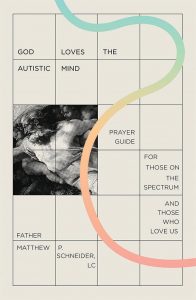 Autistic Catholics live in bittersweet times. On the one hand, we note an increasing awareness of autism in the society at large. Autistic characters appear in movies, television shows, and novels. Some corporations offer accommodations for their autistic employees, knowing that these employees can offer much if their work environment is suitable for them. Professionals in psychology are learning more about autism, in part because of their increased willingness to listen to the experiences of autistic people. On the other hand, there is still a great deal of misunderstanding about autism and autistic people. Some of this is due to outdated ideas about autism that persist. Some is due to sensationalized reports about autistic people who “act out” or behave violently without any attempt to understand why this is so.
Autistic Catholics live in bittersweet times. On the one hand, we note an increasing awareness of autism in the society at large. Autistic characters appear in movies, television shows, and novels. Some corporations offer accommodations for their autistic employees, knowing that these employees can offer much if their work environment is suitable for them. Professionals in psychology are learning more about autism, in part because of their increased willingness to listen to the experiences of autistic people. On the other hand, there is still a great deal of misunderstanding about autism and autistic people. Some of this is due to outdated ideas about autism that persist. Some is due to sensationalized reports about autistic people who “act out” or behave violently without any attempt to understand why this is so.
This same bittersweet taste can be found when autistic Catholics deal with their local parishes. The resources that are available to autistic Catholics usually focus on autistic children and their families, with faith formation and sacramental preparation in view. There is little support for autistic Catholic adults and little understanding of the unique challenges that autistic adults face when they seek to live out their Catholic faith. Though there are some resources with a more ecumenical bent — such as the Centre for Autism and Theology at the University of Aberdeen — autistic Catholic adults find little coming from Catholic sources that addresses their spiritual needs. Moreover, when autistic Catholics go to their parishes and seek spiritual guidance, they are not always welcomed or heard or understood.
Fr. Matthew Schneider’s book God Loves The Autistic Mind is one of the first efforts from a Catholic perspective to address some of these needs. How well does it do so?
After offering the reader a few statistics that outline some of the faith challenges faced by autistic people, Schneider states his purpose in writing this book quite succinctly: “The goal of this book is to help my fellow autistic Christians and their families pray better” (3). This, then, is a guide to prayer. More specifically, this book offers an overview of the stages of prayer with autistic people primarily in mind. The writing style and the examples used suggest that the intended readership is primarily autistic teenagers and adults, though non-autistic people can also find some helpful guidance on prayer here.
The book comprises two parts. The first part, a systematic guide to autistic prayer, deals with types of prayer, obstacles to prayer for autistics, how prayer deepens, and various myths about autistic people and prayer. The second part is a series of meditations, similar to lectio divina, organized around several basic themes. At the end of the book are four appendices that offer a brief introduction to autism, a list of basic Catholic prayers, a short method of mental prayer which also appears in the first chapter, and advice for Catholic autistic penitents and their confessors.
Looking at this book from the perspective of an autistic Catholic who is looking for some basic guide to prayer, there is much to commend here. For example, the author’s writing style is generally easy to follow. For many readers, to see a Catholic priest tell them that being autistic is part of God’s plan for them and not something evil may be a revelation to them. Autistic readers will appreciate such things as the connections Fr. Schneider makes between prayer and stimming, or that going to Mass can be difficult for autistic people because of the sensory overload that Mass can bring. The meditations in the second part of the book help to concretize the points that Fr. Schneider seeks to make in the first part.
No book can be all things to all people. The author acknowledges this several times in this book. However, some things are important enough that they could have been stated here without adding too much additional length to the book. For example, autism is treated in isolation. In real life, autism often comes with concurrent factors such as ADHD or trauma. Both have a significant impact on prayer. Schneider notes that autistic people can have sensory distress at Mass and advises them that this can be accepted as a “cross” that the Lord wishes them to bear. However, given that parishes (along with many other institutions) offer reasonable accommodations for the blind, the deaf, those in wheelchairs, and those who speak a different language, what role do parishes have in offering, out of Christian love, reasonable accommodations to make Mass easier for autistic people? Schneider states that autistic people have a mission to evangelize other autistic people. This is true, but not enough. If, as St. Paul teaches us in I Corinthians 12, every member of the Body of Christ is there for the whole Body’s benefit, do not autistic Catholics have a calling on behalf of the whole Church as well?
Finally, we come to the thread of cognitive dissonance that runs through this book — a thread that Schneider (and many others) seem not to notice. It is Schneider’s acceptance of the “theory of mind” hypothesis in explaining autistic people. This hypothesis is problematic both psychologically and theologically.
“Theory of mind” was a hypothesis first mentioned in psychological writing in the 1980s. One of its best-known proponents was Dr. Simon Baron Cohen. “Theory of mind” refers to the ability of a human being to perceive what another person is feeling or thinking, and to understand that another person has mental states different from one’s own. According to its proponents, “theory of mind” is one of the fundamental elements that distinguish human beings from other animals, including other primates. “Theory of mind” proponents who studied autistic people held, at the time, that autistic people had an impaired “theory of mind” or were totally lacking in it. The implication was clear. Autistic people, for those who accepted the “theory of mind” hypothesis, were not fully human. They could not be. More recent studies have shown that autistic people do not lack “theory of mind” at all. Some suggest that autistic people, in dealing with one another, are better capable of “theory of mind” than “normal” people dealing with one another. Since the hypothesis that autistic people lack “theory of mind” makes them subhuman and has been disproven scientifically, future books on autism should reflect this.
The concept that autistic people lack “theory of mind” is very problematic theologically as well. Schneider runs into this issue, seemingly unconsciously, from time to time in this book. One example is in his nineteenth reflection, “Understanding God’s Mind” (pp. 109–111). Here, Fr. Schneider wants to present God as a person (Trinity isn’t mentioned here) but he has that pesky lack of “theory of mind” allegedly preventing autistic people from seeing this. He counsels his readers to pray for the grace to go beyond “theory of mind” and meet God as a person.
There are two problems with this approach. First of all, though Church teaching holds that we can know of God’s existence by unaided reason, to know God as a person requires revelation — grace — for anyone, not only autistic people. Moreover, revelation alone is not enough. God could reveal Himself to a bug or a cat but neither would be capable of perceiving God’s personhood. No, the object of revelation must be capax Dei, capable of receiving that revelation. The object must be a human being created in God’s image. If autistic people are not capable of, in some sense, recognizing the personhood of God, they are not human from a theological point of view.
May the reader understand the importance of this little excursus on “theory of mind.” It is no less important for autistic people than the sixteenth-century debates over whether Native Americans had souls were for Bartolomé de las Casas and Native Americans as a whole.
This book, therefore, leaves this reviewer with that same bittersweet taste I spoke of at the start of this review. There is much to commend here. There are also things that need correction. This latter point is essential for the sake of autistic Catholics who make up a significant part of the anawim of the contemporary Church.
Rev. Mark Nolette is a retired priest of the Diocese of Portland (Maine) who was diagnosed as autistic in 2014. He currently serves as spiritual director for the website Autism Consecrated.
Fed by the Lord – Leonard J. DeLorenzo
DeLorenzo, Leonard J. Fed by the Lord: At-Home Scriptural Formation to Prepare Children for First Communion. Collegeville, MN: Liturgical Press, 2023. 127 pages.
Reviewed by Robert P. Miller, Ph.D.
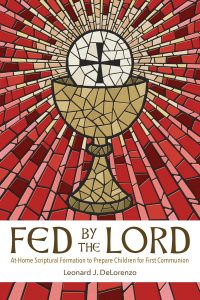 First, let me say, do not skip the introduction to this book. I had several questions before I began reading it and was happy to see that some of my questions were answered in the introduction. The introduction explains that the book was actually “co-authored” with his son Josiah as Josiah was preparing to receive his First Holy Communion. And so, the curriculum and plan were pre-tested before publication of the book. What is so gratifying is that, as the author indicates, it offers not merely a “program,” but a means of establishing a connection with your child on what are arguably the most important topics of our faith. But the connection is also made with Jesus who is present both in his word and in sacrament. As a result, the book is more a means of formation than it is a “program.”
First, let me say, do not skip the introduction to this book. I had several questions before I began reading it and was happy to see that some of my questions were answered in the introduction. The introduction explains that the book was actually “co-authored” with his son Josiah as Josiah was preparing to receive his First Holy Communion. And so, the curriculum and plan were pre-tested before publication of the book. What is so gratifying is that, as the author indicates, it offers not merely a “program,” but a means of establishing a connection with your child on what are arguably the most important topics of our faith. But the connection is also made with Jesus who is present both in his word and in sacrament. As a result, the book is more a means of formation than it is a “program.”
One of the questions that I had before reading the book was “What about parents who themselves struggle to believe in or understand the Eucharist?” DeLorenzo acknowledges these parents early in the introduction, noting that the majority of Catholics do not believe in the Real Presence of Christ in the Sacrament. He addresses this stating, “For many of us, this begins as a daunting and uncertain task: we might question our own faith, or feel awkward in our wording or mannerisms in sharing faith, or recognize our own lack of knowledge when it comes to Scripture or the particularities of Catholic doctrine. I had all this in mind as I prepared this book for you, especially because I felt all those things myself . . .”
The book is, in ways appropriate for children and their parents, an introduction to biblical typology, where a person, place, thing, or event in the Old Testament foreshadows something greater in the New Testament. As such, DeLorenzo has chosen six passages from the Old Testament that anticipate the Eucharist in the New Testament and six passages from the New Testament, all of which are from the Gospels, that unveil the beauty of the Eucharist in different ways. The passages that the author addresses are:
Genesis 2:4–9; 15–17 (The Human Being and the Garden)
Genesis 3:1–10 (The Forbidden Fruit)
Exodus 12:1–20 (The Passover)
Exodus 16:1–35 (The Manna)
1 Kings 19:1–21 (The Prophet’s Strength)
2 Kings 4:42–44 (The Abundant Bread)
Mark 6:30–44 (Jesus Feeds the Five Thousand)
John 2:1–11 (Jesus Turns Water to Wine at Cana)
John 6:25–38, 41–42, 48–58 (Jesus is the Bread of Life)
Luke 22:1–2, 14–20 (Jesus Institutes the Eucharist at the Last Supper)
Luke 24:13–37 (Jesus Redeems the Two Bound for Emmaus)
John 21:1–14 (Jesus Renews His Disciples on the Seashore)
Each of the chapters addresses a different biblical passage and is broken into two parts: the first is the guide for parents, which explains each biblical passage; and the second is a guide for how to direct a session with your child. What is especially helpful in instructing children with these passages is that the author makes the connection to the previous chapter in part two of each chapter and encourages the parent and child to review the previous story before moving on.
The book is well researched and uses modern scholarly sources. There are occasions where the author makes reference to Hebrew or Greek words, such as ‘adam, ‘adamah, manna, and eucharisteō. The reader should not be intimidated by this as the author makes their meaning and relevance clear. It may even be entertaining intriguing for a child to claim that they know some Hebrew and Greek!
Some of the stories may be unfamiliar to both the parent as well as the child. Even if a parent or child is familiar with some of the names, they may not be familiar with the stories. DeLorenzo does a nice job of summarizing the main points and characters to get to the heart of how the story relates to the Eucharist. For example, some may be familiar with the names Elijah, Ahab, and Jezebel in 1 Kings 19, but may not be familiar with the significance of the story, particularly, how an angel from God comes to feed his servant, the prophet Elijah, and how the bread strengthens Elijah to go and meet God.
A word of advice to whoever is instructing the child: Please take the time to not only read the chapter several times before going over it with the child, but also read the stories from scripture themselves several times in advance. This preparation will give the instructor more confidence when reviewing the material with the child. This book is sure to make both parents and children more deeply aware of how we are Fed by the Lord at every Mass. When read prayerfully, it is sure to bring you closer to Christ and your child.
Dr. Robert Miller is an Associate Professor of Religious Studies at Mount St. Mary College, Newburgh, NY.
Let Beauty Speak – Jimmy Mitchell
Mitchell, Jimmy. Let Beauty Speak: The Art of Being Human in a Culture of Noise. San Francisco: Ignatius Press, 2023. 144.
Reviewed by Maria Cintorino.
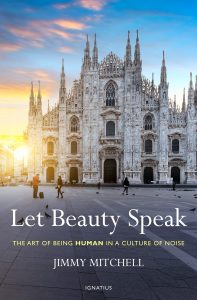 Beauty is perhaps the most fascinating path to God, Benedict XVI preached. And perhaps it is the most needed in today’s culture. For any encounter with authentic beauty disposes the viewer to become transcended, awakens within an understanding of his existence, incites joy, and inflicts a wound: it creates a desire, a certain restlessness for the Ultimate Beauty.
Beauty is perhaps the most fascinating path to God, Benedict XVI preached. And perhaps it is the most needed in today’s culture. For any encounter with authentic beauty disposes the viewer to become transcended, awakens within an understanding of his existence, incites joy, and inflicts a wound: it creates a desire, a certain restlessness for the Ultimate Beauty.
It challenges us to step outside ourselves, viewing our lives and our surroundings in a new light. Beauty offers a sacramental — an incarnational — worldview, for authentic beauty reflects the beauty of God. Benedict teaches that beauty “opens up our eyes” where we rediscover the “joy of seeing.” This manner of seeing, this way of life, needs to be reclaimed. Why? Because a relativistic world consumed with success and dominated by noise and stimulation loses its identity when it no longer takes time to be still and be captivated by beauty.
Jimmy Mitchell’s Let Beauty Speak: The Art of Being Human in a Culture of Noise seeks to remedy this. The book’s purpose is simple: it teaches how to reclaim being human through encountering and radiating beauty. In today’s culture, the author writes, “it’s easy to lose our hunger for knowledge and objective reality. It doesn’t take much to be distracted and deceived by the world’s noise” (92). And when we do, beauty is lost. Mitchell’s work proposes an antidote: arming the next generation of saints with practical ways to “rise up and evangelize our culture of noise through their distinctly Christian way of life” (16).
Mitchell, who is greatly influenced by Benedict XVI’s thought, proposes beauty as an essential element of the Christian life: it is a way of life. The book guides the reader in discovering how we can experience and cultivate beauty in our daily life, thereby becoming authentically human.
Learning how to be human in a listless and distracted culture which no longer marvels or seeks transcendence requires work and recollection. For beauty — whether it be music, art, or a Christian’s witness — is “always a glimpse into the Father’s heart” (31). Hence, for Mitchell, reclaiming beauty in our lives is essential. When we do, we become transformed, live humanity well, renew our communities and culture, and become effective evangelizers for “our way of life is how beauty evangelizes best” (149). This is the way of the saints. They saw God’s beauty in creation and revealed His beauty in their lives. Their personal renewal paved the way to cultural renewal, for “the beauty of their holiness evangelized the world around them” (13).
To live as did the saints — to cultivate beauty as a way of life — the author presents ten essential criteria: wonder, freedom, friendship, prayer, leisure, work, community, suffering, mission, and culture. These steps — each addressed in a chapter — fosters a Christocentric way of life: a culture of beauty. Wonder transcends, interior freedom strengthens virtue, friendship encourages and inspires, prayer unites us to God, leisure fosters contemplative prayer, suffering and work sanctifies, community unites, and mission incorporates us into God’s plan.
The book does not present these principles as speculative facts or in scholastic terms. A natural storyteller, Mitchell crafts his message in a relatable and straightforward style. He commences each chapter with a fascinating, personal story to segue each principle before giving an overview of it. And he concludes each chapter with two helpful sections: “Getting Practical” and “Further Reading.” The former lists practical ways in which the reader can develop the principles spoken of in the chapter. Examples include: fostering wonder by hiking and spending time in nature, growing in friendship by examining whether our friendships are virtuous, cultivating community by hosting a movie night or book club, and engaging in the Church’s mission by committing to volunteer with a local apostolate. Meanwhile, in “Further Reading,” Mitchell suggests several books and resources for the reader to learn about the specific principle further.
Mitchell’s work is an effortless read for those who wish to explore the nature of beauty and the effect that it has in their lives. Scattered with personal stories, anecdotes, lessons from literature, and wisdom throughout the centuries — from ancient philosophers to recent Church documents and pontiffs — the lessons the author conveys will be easy for any reader to grasp. The structure of the book naturally lends itself well to church study groups and small groups discussions. Anyone who wishes to reexamine beauty’s necessity and reclaim beauty as a way of life will benefit from the author’s wisdom.
Maria Cintorino writes from Virginia. Her work has appeared in a variety of publications, including National Catholic Register, Our Sunday Visitor, Dappled Things and Crisis Magazine.
Forgiven – Daughters of St. Paul
Dyck, Sr. Orianne Pietra René, FSP and Sr. Allison Regina Gliot, FSP. Forgiven: A Guide to Confession & the Examen Prayer. Pauline Books & Media, 2024, 135 pages.
Reviewed by Lawrence Montz.
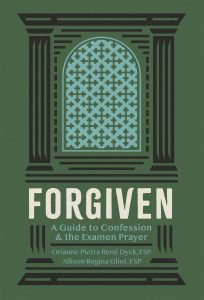 Rather than title this book Forgiven: A Guide to Confession & the Examen Prayer, the authors could have aptly entitled it, “An Encounter With the God of Mercy.” Sisters Orianne Pietra René Dyck, FSP and Allison Regina Gliot, FSP, of the Daughters of St. Paul, have written a practical handbook to help facilitate the reader in understanding and preparing for the sacrament of forgiveness and God’s mercy. The Sisters provide Catholics with the basic tools and reasoning surrounding the Sacrament of Reconciliation. Their guide is useful to neophytes and mature believers alike. Practicing Catholics may think they are familiar with the nuances of this gift because of lifelong utilization; however, how many of these experienced worshipers appreciate the appropriateness of having a meaningful dialogue with their confessor, not simply an enumeration of their offences? How many regular penitents realize that it is proper to arrange a private meeting at a convenient time, as the priest is bound to make himself available when sinners reasonably ask for his service? Certainly believers should not ignore the priest shortage or the Lenten seasonal crunch, particularly if there are grievous issues to be considered. The faithful should approach Reconciliation with humility, trusting God’s mercy; however, the authors caution that they should also properly prepare themselves.
Rather than title this book Forgiven: A Guide to Confession & the Examen Prayer, the authors could have aptly entitled it, “An Encounter With the God of Mercy.” Sisters Orianne Pietra René Dyck, FSP and Allison Regina Gliot, FSP, of the Daughters of St. Paul, have written a practical handbook to help facilitate the reader in understanding and preparing for the sacrament of forgiveness and God’s mercy. The Sisters provide Catholics with the basic tools and reasoning surrounding the Sacrament of Reconciliation. Their guide is useful to neophytes and mature believers alike. Practicing Catholics may think they are familiar with the nuances of this gift because of lifelong utilization; however, how many of these experienced worshipers appreciate the appropriateness of having a meaningful dialogue with their confessor, not simply an enumeration of their offences? How many regular penitents realize that it is proper to arrange a private meeting at a convenient time, as the priest is bound to make himself available when sinners reasonably ask for his service? Certainly believers should not ignore the priest shortage or the Lenten seasonal crunch, particularly if there are grievous issues to be considered. The faithful should approach Reconciliation with humility, trusting God’s mercy; however, the authors caution that they should also properly prepare themselves.
Per the Sisters, the rudiments of receiving the graces of a valid confession include three components. A proper confession should be made verbally. We must have contrition or sorrow for our sins and the resolve not to repeat the offences. Contrition is not necessarily a feeling, because that may simply be a personal reaction to our sinfulness, but a desire to change for the love of God. The Lord understands that we are flawed and that our sorrow may be imperfect; after all, this is why he gave us the Sacrament of Reconciliation. Lastly, we must perform the penance given by Christ’s representative. Those are self-evident for longtime Catholics, but the Sisters also delve into the reasoning behind the essentials. Guidance is offered to the prospective penitent on preparing for confession with advice on the considerations and reasoning for an examination of conscience as well as a listing of sins of omission or commission we should consider. Potential failures, not just in the sense of “thou shall not” considerations but behavior that may distance us from God through self-will. The authors proceed to walk a penitent through an actual celebration of the sacrament itself from the opening sign of the cross to the confessor’s absolution. The role of the Holy Spirit in the process and the allowance for the proper depth of preparation are emphasized. These exhortations are followed by a FAQ section that offers additional reasoning to help the penitent understand the gravity of what they have done and conceivably what should be done about it.
One of the most important sections of the book is advice on the importance of using a daily Examen to help the reader build their relationship with God regularly rather than waiting for a hurried examination prior to reconciliation in the sacrament. According to the Catechism of the Catholic Church (CCC), sin is a transgression against reason that turns our hearts away from our all-loving God and ultimately reflects a self-willed desire to become “like gods.” The sacrifice of Jesus is the source of forgiveness. Repentance for sins and the need to change our lives back into conformity with the divine was highlighted by Christ within the parable of the prodigal son that emphasizes the foibles of self-will and the mercy of the father. The Examen helps us recognize the presence of sin in our lives and our openness to God’s grace on a regular basis. It is not the same as an examination of conscience where we ponder our offences, but regular reflections on the presence or absence of God in the ordinary occurrences of our day. The Examen is not about “tracking mistakes.” St. Ignatius of Loyola, founder of the Jesuits and the originator of the more modern form of the Examen, recognizing the importance of knowing self, urged his followers to open themselves to the Examen more often than daily if possible.
In order to help us build that regular relationship with Christ, suggested Scripture readings beneficial for drawing closer to God and helping us recognize our sinful natures are presented. The Sisters advocate the use of traditional meditations and prayers like the Sorrowful Mysteries of the Rosary, the Stations of the Cross, and the penitential Psalm 51, prayed by Christ’s Church, especially on Fridays, as recommended aids to a proper understanding of the depth of the mercy and love of God for his creatures.
Perhaps the final chapters in the book are the most poignant to all penitents if they truly desire to have their lives and the lives of their neighbors changed for the better. Ezekiel 33:11 in the Douay-Rheims translation states, “As I live, saith the Lord God, I desire not the death of the wicked, but that the wicked turn from his ways, and live.” Almighty God has assured us of his love and mercy; therefore, what have we to fear if we trust in Him? God affirms his love for all of his creation and wants us to live our lives to the full. The Sisters have provided us with a guide to the Sacrament of Reconciliation which can restore harmony with the Lord and refresh our friendship if we only allow him to heal us by accepting the graces of a “good” confession, made easier by the suggestions of the authors.
Lawrence Montz is a Benedictine Oblate of St. Gregory Abbey in Shawnee, Oklahoma, past Serran District Governor of Dallas, and serves as his Knights of Columbus council’s Vocations Program Director. He resides in the Dallas Diocese.

Recent Comments